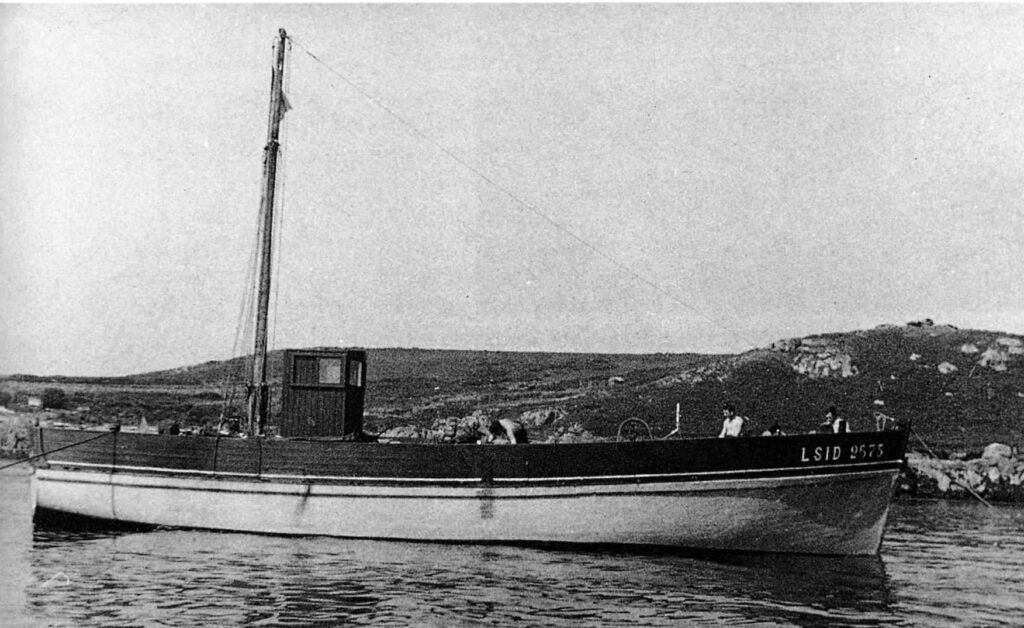Helford and the SOE
4 February 2025The Helford boats
4 February 2025This is a transcript of a document by Lt Cdr Nigel Warington Smyth Senior Officer Inshore Patrol (SOIP) held in the NMMC Archives.1 It is undated but the events described fit the description of Operation KNOCKOUT 16-19 September 1944. 2
When the Germans started to withdraw their garrisons from outlying ports in Brittany to centres for the last stand, such as Brest, L’Orient and Saint Nazaire, the Free French Organisation known to us as the FFI3 were pleading for supplies of small arms, grenades and plastic explosives to harass the Germans whilst they were on the move and to destroy such of their enclaves as still remained.4
One morning whilst aboard HMS Sunbeam in the Helford River5 I received orders from the Admiralty to proceed as soon as possible to the small fishing port of L’Aberwrac’h on the north coast of Brittany where I was to meet a D class ML under the command of Lieutenant Seddon RNVR. I was informed that Lieutenant Seddon’s vessel would be loaded with an assortment of arms and explosives and I was to join his ship and was to ensure that the arms were safely delivered to Colonel Berthaud of the FFI who would meet us at Benodet, a town at the mouth of the Odet River. It is a lovely river situated to the eastwards of the Pointe de Penmarch and is nearly as beautiful as our own Helford River.
I have no idea as to the reason why I was detailed off for this expedition, because I knew Lieutenant Seddon to be a first class officer who could and would have done the job on his own with ease.

I had often sailed in my own boat to Benodet and I thought it was an excellent excuse for me to have a wartime yachting cruise to one of my old peacetime haunts and so I discarded the idea of suggesting to their Lordships that my presence was quite unnecessary. Instead I decided to take our 50 foot Douarnenez sardine boat MFV P11.6 As she was fully ready with fuel and water and was lying alongside Sunbeam, and we only had to add a week’s provisions to let go. To our store list we added a quantity of sugar and soap both of which were in short supply or non-existent in L’Aberwrac’h.
We left around 1900 hrs and with a quiet night we were averaging 8 knots and entering the L’Aberwrac’h River shortly after dawn. I was surprised to find a British Sloop at anchor near the mouth of the river. I went aboard to pay my respects and advised the Commanding Officer that I was expecting to rendezvous with a D Class ML.
Almost immediately I spotted Lt Seddon on his way up the Grand Chenal and I was soon aboard and off we went at high speed. We passed through the famous Chenal du Four between the Island of Ushant and the mainland, and then set a course for the Raz de Sein, a channel inside the Isle de Sein which saves many miles, and oddly enough the channel in which the old S Class Destroyer “Cutty Sark” was dive bombed and stopped in 1941 when I was serving in her.
On our way across from the South end of the Chenal du Four to the North end of the Raz de Sein we came under fire from German batteries sited on the high land above Cap de la Chevre where the Croix de Lorraine Monument now stands. A number of shells fell around and about but they were all wide of the mark.
It was a lovely fine day with light winds and a smooth sea so we could enjoy our cruise to the full. As we had anticipated, the Germans had changed the position of all the navigational buoys in the entrance to Benodet but since the visibility was good we had little difficulty in plotting our position from recognisable Islands and stone Towers.
We anchored off Benodet in the late afternoon. Colonel Berthaud and his men awaited us. They explained that they were short of transport and fuel and asked us if with the assistance of an Odet River pilot we could go up to Quimper at the head of the river. This we agreed provided that our vessel would be piloted down the Benodet as soon as the cargo had been unloaded, since the Upper River dries out at low tide and we wanted to be away by dawn.
An hour or so before hightide we set off an must say that as dusk was falling I thought I had seldom seen a more beautiful river.
We duly arrived alongside a quay in the town of Quimper to find a well-organised gang of Bretons ready to take over our cargo. Every item landed was checked and signed for as though we had a load of Gold Bricks from the Bank of England.
Colonel Berthaud said he had booked accommodation for Lt. Seddon and me for the night, and he had also arranged for a dinner party, furthermore a car would be at the hotel front door to take [us] to Benodet at first light.
The Germans had destroyed the power station as well as the gasworks before they left so we took dinner in candle light in an underground dungeon of great size. I should think there were fifty or more people present. The food and wine was excellent. I know not how the cooks had managed to do their job.
When the dinner was over the party settled down to talk and drink brandy. Whilst I was yarning with a party of Bretons on such simple subjects as the German occupation and the Breton Fishing fleet I observed Lt Seddon in close discussion with Colonel Berthaud.
In a short time they came over to my table to ask my opinion on a scheme which they had worked out. It seemed that whilst the FFI had completely wiped out the German Garrison at Concarneau when they were moving to Brest they had been unable to dislodge the Garrison at Audienne. The idea was that when the D Class ML should arrive off Audienne at about daylight and should then give the Germans a sharp bombardment and whilst their attention was diverted the FFI with their newly acquired armament would attack over the hill at the back of the enclave.
I asked if anybody knew the size and fire power of the German defences. It appeared that nobody did. I explained that I was now “Functus Officio” as my job had been completed and it was Lt Seddon’s decision as to what he was prepared to do.7 I did say that I thought a quick run in and shoot up followed by a speedy withdrawal might be a good idea.
We were then guided through the dark and silent streets to our Hotel. After a few hours sleep in a comfortable bed with clean white sheets, I was called by a young girl with a jug of strong coffee and crisp white rolls. It was dark when Seddon and I left the car bound for Benodet there to rejoin our vessel.
In the dawn we were approaching Audienne and Lt Seddon increased speed closing the coast about ½ mile and then beam on to the shore he opened fire with everything we had that could shoot. Alas he made a second run by which time the Huns had woken up and retaliated with a fusillade from what we judged to be 88mm guns.
We were hit by two or three shells and retired to sea at high speed under cover of a massive smoke screen.
The damage survey revealed that one shot had gone through the side of the vessel and had demolished the lavatory pan in the Petty Officers lavatory upon which was seated a Petty Officer. It missed the Petty Officer but his bottom had been cut by the remains of the pan.
The shell continued on its way through the fuel tank full of 100 octane petrol, through the port side of the vessel and then exploded in the sea.
The resultant leakage of petrol into the bilges produced some potentially explosive vapour but the anti-gas drill proved effective and we suffered no explosions. Considerable other damage had been done but no one had been killed or wounded.
Later in the day I transferred to MFV P11 and set off for Helford whilst Seddon pushed on up Channel to his base.
On the way I learned that the Scottish Sub Lieutenant who was left in command of P11 had been to the Island of Ushant to see what was happening there. He found that the small garrison of Germans had surrendered to the inhabitants and he asked for the Islanders permission to shoot the Germans. Fortunately the Islanders did not agree to this proposal, not it seems that they objected to shooting Germans, but as the Germans were now usefully employed in the dangerous work of dismantling their own land mines, booby traps and barbed wire entanglements they were of more use alive than dead.
Some weeks later I received a letter from the Admiralty to the effect that it was proposed to court-martial Lt Seddon for hazarding his ship and since I had been on board at the time of the incident they invited my observations on two points:
1 Why had Lt Seddon not obtained permission from the Commander-in-Chief Plymouth to carry out the attack on Audierne
2 Why had I not, as his superior Officer, countermanded the proposed action.
Before I had time to draft an answer to this document I had to visit Commander Luard RN (The Naval Liaison Officer with the RAF at St Eval). Luard was somewhat late for the appointment so I filled in time reading the vast amount of Notices stuck around the walls of his offer.
Here was the answer to my problem. A printed copy of one of Lord Nelson’s Orders to his Officers. I copied it but I no longer have that copy. The Order was roughly as follows:
“I have no patience with Commanding Officers who defer action against the enemy by continually signalling for permission to do this or to do that. I expect my Commanding Officers to seek out the enemy wherever he may be found and instantly to engage him closely whatever the odds.”
In my reply to the Admiralty I reminded them of Lord Nelson’s Orders. I added the information which I had just received that Colonel Berthaud’s attack on Audierne had been completely successful and had been carried out with minimal casualties.
Written in 1944 by Lieutenant Commander Nigel Warington Smyth RNVR OBE SIS, Senior Officer Inshore Patrol (SOIP) in command of HMS Sunbeam.
Lieutenant Seddon RNVR was in SOE (Special Operations Executive Operations) which was set up to help French Resistance movement on the Continent with Arms etc.
- Archive reference 0181.0002
- Secret Flotillas, Brooks Richards, HMSO
- French Forces of the Interior – the French Resistance
- US troops had reached the south coast of the Brittany peninsula by 7 August before turning eastwards, leaving a small force to mop up pockets of resistance
- HMS Sunbeam was the HQ ship for the Inshore Patrol Flotilla – a combination of Naval SIS and SOE vessels based in the Helford
- Formally MFV 2021 but originally a pinasse called Ar-Morscoul, a French fishing trawler, which had been rescued from the bottom of Newlyn harbour and kitted out with a new engine. She sailed under the new name of Vas-y-Voir ostensibly from the Ile d’Yeu
- The author had been a lawyer before the War.
